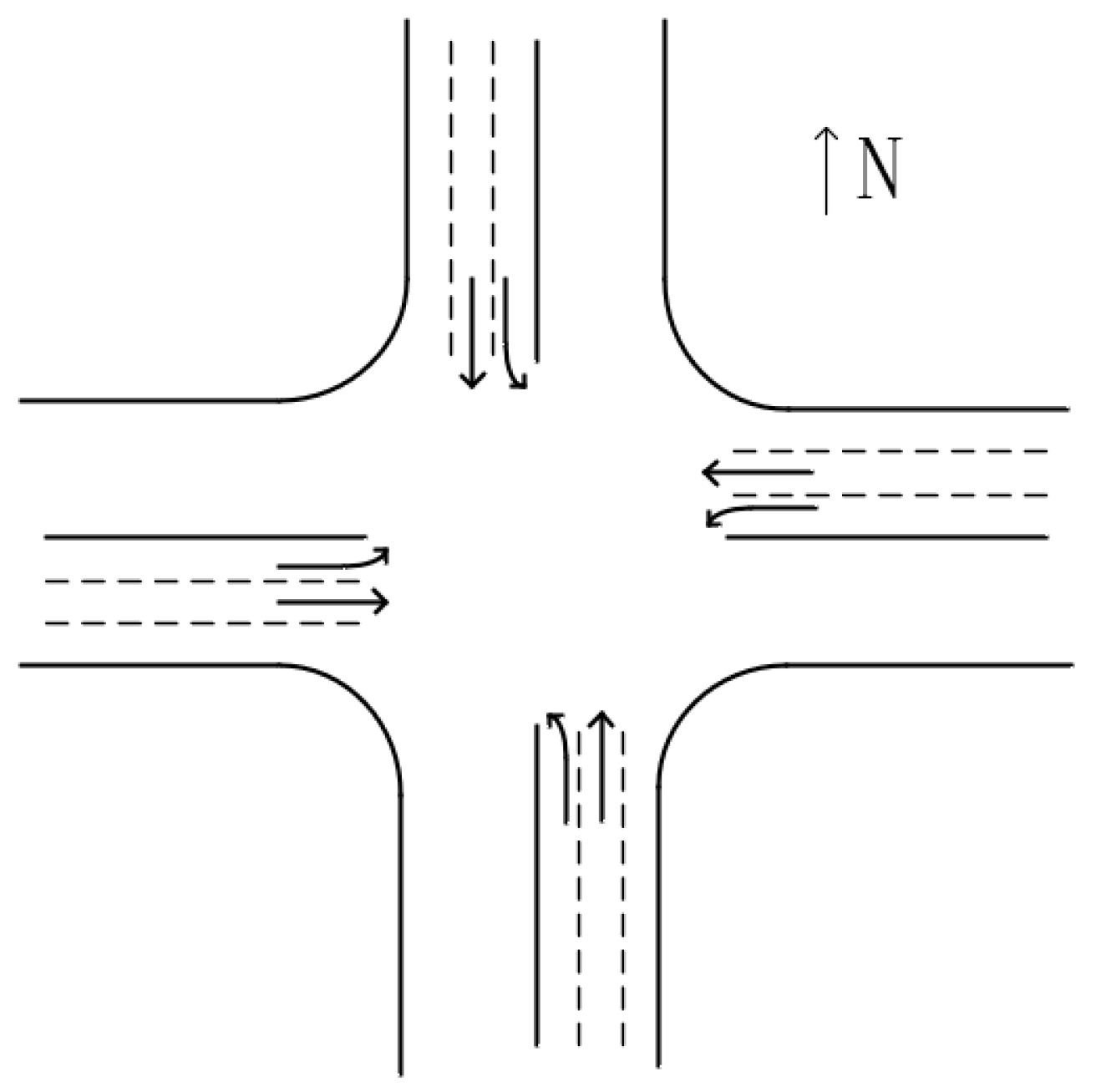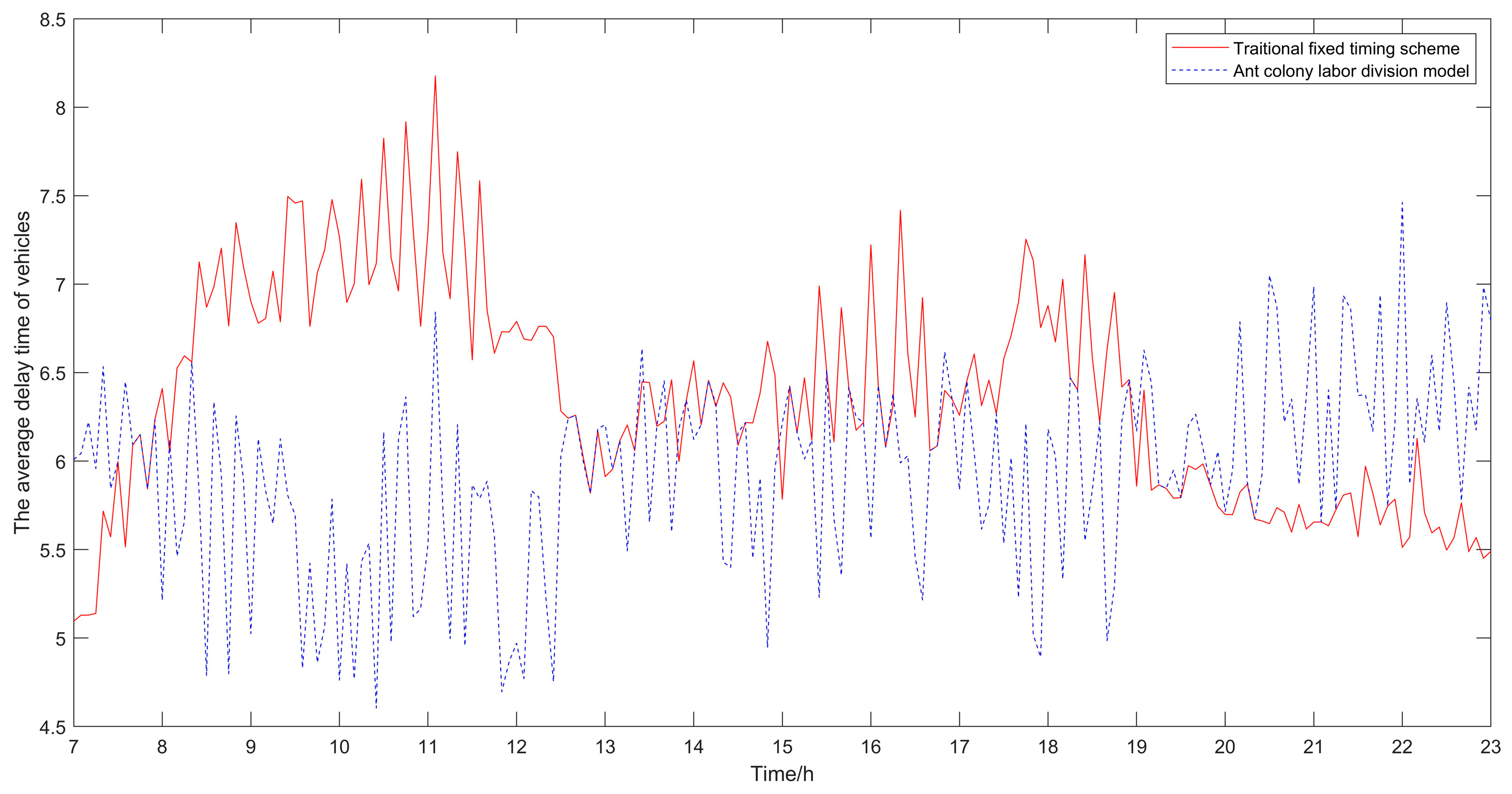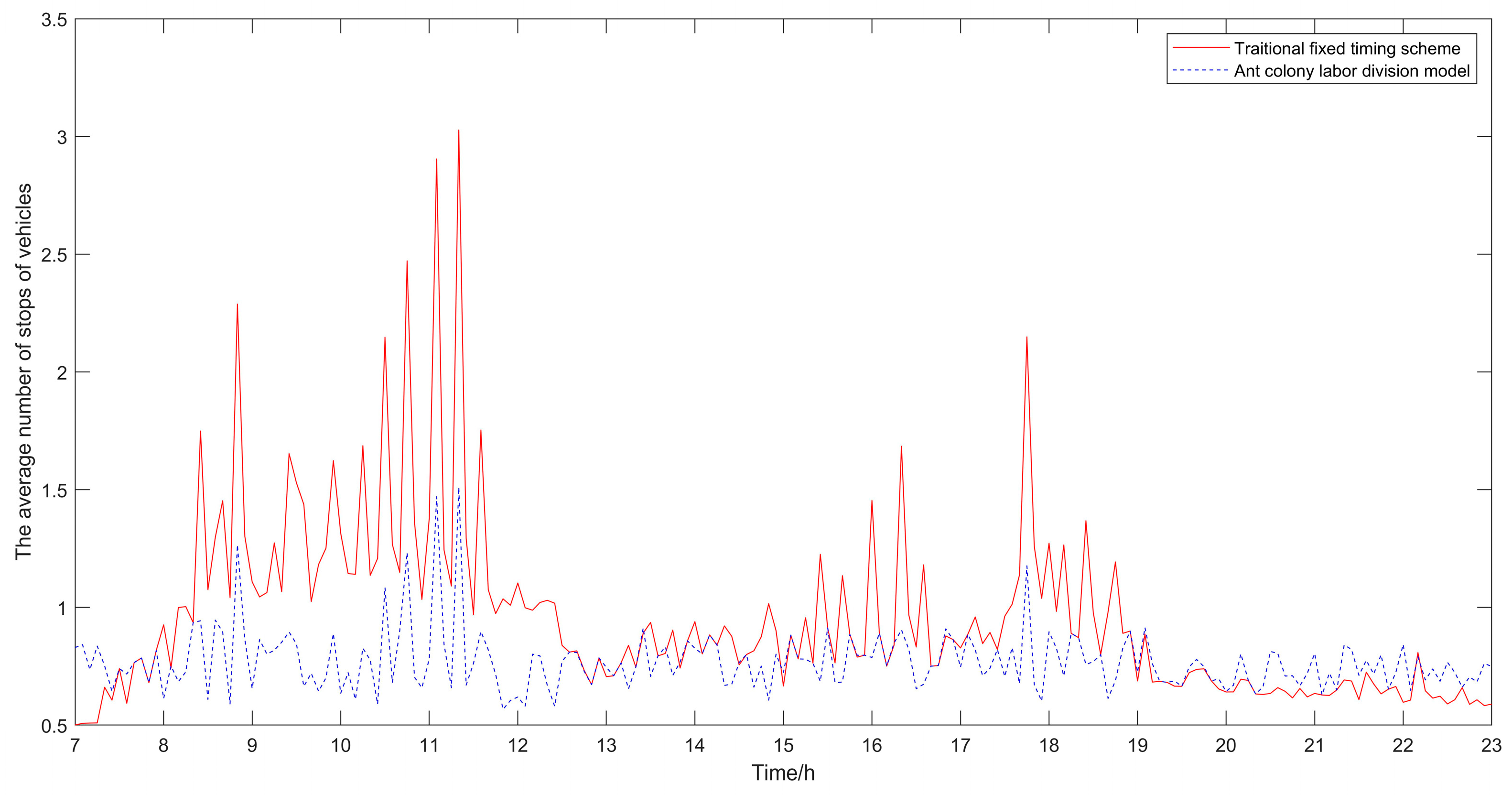How to Improve Urban Intelligent Traffic? A Case Study Using Traffic Signal Timing Optimization Model Based on Swarm Intelligence Algorithm
Abstract
1. Introduction
2. Ant Colony Labor Division Model
2.1. Basic Ant Colony Labor Division Model
2.2. Optimization of Ant Colony Labor Division Model
- qi—the traffic flow at phase i;
- tgi—the green time at phase i;
- si+—the stimulus value of increasing green time at phase i;
- si−—the stimulus value for the reduction of green time at phase i;
- θi+—the response threshold of increasing the green time in phase i;
- θi−—the response threshold of reducing the green time in phase i;
- Pi+—the selection probability of the green time increase in phase i;
- Pi−—the selection probability of the green time decrease in phase i;
- Pi*—the selection probability of the green time invariant in phase i;
- ξi+—the increment of green time for phase i;
- ξi−—the reduction of green time for phase i;
- λi—the green ratio in phase i;
- xi—the effective green time of phase i;
- yi—the degree of traffic flow saturation;
- C—the cycle time;
- Di—the delay time of vehicles in phase i;
- Hi—the number of stops of vehicles in phase i;
- Qi—the traffic capacity in phase i.
2.2.1. Environmental Stimulus
2.2.2. Response Threshold
2.2.3. Probability of Task Execution
2.2.4. Task Response
2.2.5. Algorithm implementation
- (1)
- Parameters including phase number n, initial green time, scale coefficient k, maximum iteration number N, etc., are initialized.
- (2)
- The initial number of iterations is set to 1.
- (3)
- According to Equations (3)–(8), the environmental stimulus, response threshold, and probability of task execution of each phase are calculated.
- (4)
- If Pi+ is greater than β or Pi− is greater than α, jump to (5), otherwise, jump to (6).
- (5)
- According to Equation (10) or (11), the change amount of green time is calculated and then the green time of each phase is updated.
- (6)
- According to Equations (12)–(17), the delay time of vehicles Di, stopping times of vehicles Hi, and the road traffic capacity Qi are calculated.
- (7)
- The value of evaluation function F(x, c) is calculated according to Equation (18).
- (8)
- Update the min F(x,c), and the corresponding optimal solution of green time.
- (9)
- Increase the number of iterations by 1.
- (10)
- Judge whether the maximum number of iterations has been reached. If so, jump to (11); otherwise, jump to (3).
- (11)
- Output the optimal solution.
3. Experiment and Analysis
3.1. Design of the Signal Phase
3.2. Experiment Data
3.3. Evaluation Index
3.4. Experiment
3.5. Result Analysis
4. Conclusions
Author Contributions
Funding
Institutional Review Board Statement
Informed Consent Statement
Data Availability Statement
Acknowledgments
Conflicts of Interest
References
- Dorigo, M. Optimization, Learning and Natural Algorithma. Ph. D. Thesis, Dipartmento di Elettronica, Politecnico di Milano, Milan, Italy, 1992. (In Italian). [Google Scholar]
- Liu, F.; Zhong, S. A Review of Foreign Literatures on “swarm intelligence” Research. Stud. Dialectics Nat. 2012, 28, 114–117. (In Chinese) [Google Scholar] [CrossRef]
- Kennedy, J.; Eberhart, R.C. Particle swarm optimization. In Proceedings of the IEEE International Conference on Neural Networks, Perth, Australia, 27 November–1 December 1995. [Google Scholar]
- Li, X.; Shao, Z.; Qian, J. An Optimizing Method Based on Autonomous Animats: Fish-swarm Algorithm. Syst. Eng. Theory Pract. 2002, 22, 32–38. [Google Scholar]
- Karaboga, D. An Idea Based on Honey Bee Swarm for Numerical Optimization; Computers Engineering Department, Engineering Faculty, Erciyes University: Kayseri, Turkey, 2005. [Google Scholar]
- Chen, T.; Li, Q.; Fu, P.; Yang, J.; Xu, C.; Cong, G.; Li, G. Public Opinion Polarization by Individual Revenue from the Social Preference Theory. Int. J. Environ. Res. Public Health 2020, 17, 946. [Google Scholar] [CrossRef] [PubMed]
- Ni, X.; Zhou, H.; Chen, W. Addition of an Emotionally Stable Node in the SOSa-SPSa Model for Group Emotional Contagion of Panic in Public Health Emergency: Implications for Epidemic Emergency Responses. Int. J. Environ. Res. Public Health 2020, 17, 5044. [Google Scholar] [CrossRef] [PubMed]
- Chen, T.; Wang, Y.; Yang, J.; Cong, G. Modeling Public Opinion Reversal Process with the Considerations of External Intervention Information and Individual Internal Characteristics. Healthcare 2020, 8, 160. [Google Scholar] [CrossRef] [PubMed]
- Chen, T.; Li, Q.; Fu, P.; Yang, J.; Xu, C.; Cong, G.; Li, G. Modeling of the Public Opinion Polarization Process with the Considerations of Individual Heterogeneity and Dynamic Conformity. Mathematics 2019, 7, 917. [Google Scholar] [CrossRef]
- Chen, W.; Jiang, Z.; Guo, H.; Ni, X. Fall Detection Based on Key Points of Human-Skeleton Using OpenPose. Symmetry 2020, 12, 744. [Google Scholar] [CrossRef]
- Chen, T.; Peng, L.; Yin, X.; Rong, J.; Yang, J.; Cong, G. Analysis of User Satisfaction with Online Education Platforms in China during the COVID-19 Pandemic. Healthcare 2020, 8, 200. [Google Scholar] [CrossRef]
- Chen, W.; Chen, S.; Guo, H.; Ni, X. Welding flame detection based on color recognition and progressive probabilistic Hough transform. Concurr. Comput. Pract. Exp. 2020, 32, e5815. [Google Scholar] [CrossRef]
- Chen, T.; Wu, S.; Yang, J.; Cong, G. Risk Propagation Model and Its Simulation of Emergency Logistics Network Based on Material Reliability. Int. J. Environ. Res. Public Health 2019, 16, 4677. [Google Scholar] [CrossRef] [PubMed]
- Chen, T.; Wu, S.; Yang, J.; Cong, G.; Li, G. Modeling of Emergency Supply Scheduling Problem Based on Reliability and Its Solution Algorithm under Variable Road Network after Sudden-Onset Disasters. Complexity 2020. [Google Scholar] [CrossRef]
- Xiao, R.; Wang, Y. Research Progress of Self-organized Labor Division in Swarm Intelligence. Inf. Control. 2019, 48, 129–139. [Google Scholar]
- Zhang, W.; Zhang, B.; Qiu, W. The Use of Ant Colony Model in the Staff Deployment Problem. Adv. Mater. Res. 2011, 317, 1501–1506. [Google Scholar] [CrossRef]
- Xiao, R.; Chen, W.; Chen, T. Modeling of Ant Colony’s Labor Division for the Multi-Project Scheduling Problem and Its Solution by PSO. J. Comput. Theor. Nanosci. 2012, 9, 223–232. [Google Scholar] [CrossRef]
- Wang, Y.; Wang, Y.; Sun, J.; Huang, C.; Zhang, X. A stimulus–response-based allocation method for the circle packing problem with equilibrium constraints. Phys. A Stat. Mech. Appl. 2019, 522, 232–247. [Google Scholar] [CrossRef]
- Wang, Y.; Xiao, R. Structure Emergence of Spatial Fidelity Zones in Biosystems. J. Bioinform. Intell. Control 2014, 3, 90–99. [Google Scholar] [CrossRef]
- Wu, H.; Li, H.; Xiao, R.; Liu, J. Modeling and simulation of dynamic ant colony’s labor division for task allocation of UAV swarm. Phys. A Stat. Mech. Appl. 2018, 491, 127–141. [Google Scholar] [CrossRef]
- Xiao, R.; Wu, H.; Hu, L.; Hu, J. A swarm intelligence labor division approach to solving complex area coverage problems of swarm robots. Int. J. Bio Inspired Comput. 2020, 15, 224–238. [Google Scholar] [CrossRef]
- Su, H. Study on the Optimization Methods of Signal Timing Parameters of Urban Traffic Control. Ph. D. Thesis, Jilin University, Changchun, China, 2004. [Google Scholar]
- Hakim, G.P.N.; Firdausi, A.; Alaydrus, M.; Budiyanto, S. Dynamic Traffic Light Timing Control System using Fuzzy TOPSIS Algorithm. In IOP Conference Series Materials Science and Engineering; IOP: London, UK, 2018; Volume 453. [Google Scholar]
- Guo, P.; Lei, D.; Ye, L. An Indefinite Cycle Traffic Light Timing Strategy. Int. J. Adv. Comput. Sci. Appl. 2018, 9, 1–12. [Google Scholar] [CrossRef][Green Version]
- Chen, Y.; Chen, K.; Hsiung, P.A. Dynamic traffic light optimization and Control System using model-predictive control method. In Proceedings of the 2016 IEEE 19th International Conference on Intelligent Transportation Systems (ITSC), Rio de Janeiro, Brazil, 1–4 November 2016; pp. 2366–2371. [Google Scholar]
- Qi, A. Research on Timing Optimization of Regional Traffic Signals based on Improved Genetic Algorithm. In Proceedings of the 2018 3rd International Workshop on Materials Engineering and Computer Sciences (IWMECS 2018), Jinan, China, 27–28 January 2018. [Google Scholar]
- Bonabeau, E.; Theraulaz, G.; Deneubourg, J. Fixed Response Thresholds and the Regulation of Division of Labor in Insect Societies. Bull. Math. Biol. 1998, 60, 753–807. [Google Scholar] [CrossRef]
- Castello, E.; Yamamoto, T.; Nakamura, Y.; Ishiguro, H. Foraging optimization in swarm robotic systems based on an adaptive response threshold model. Adv. Robot. 2014, 28, 1343–1356. [Google Scholar] [CrossRef]
- Wang, B. The Research on Signal Timing Algorithm Intersections Based on Ant Colony Algorithm and Fuzzy Control Theory; Jilin University: Changchun, China, 2018. [Google Scholar]
- Yang, P.; Zhang, S. Traffic Management and Control; China Communication Press: Beijing, China, 1995. [Google Scholar]
- Chen, X.; Qian, D.; Shi, D. Multi-objective optimization method for signal timing of urban traffic intersection. Mod. Electron. Tech. 2016, 39, 19–22. [Google Scholar]
- He, J. Traffic Signal Timing Optimization Based on Ant Colony Algorithm; Shanxi University of Science and Technology: Taiyuan, China, 2012. [Google Scholar]







| Phase i | Traditional Fixed Timing Scheme/s | Ant Colony Labor Division Model/s | Relative Change/% |
|---|---|---|---|
| Phase 1 | 6.65 | 6.04 | −9.06 |
| Phase 2 | 6.27 | 5.59 | −10.71 |
| Phase 3 | 6.63 | 5.97 | −9.95 |
| Phase 4 | 6.15 | 5.23 | −14.83 |
| The average of the intersections | 6.53 | 5.86 | −10.25 |
| Phase i | Traditional Fixed Timing Scheme | Ant Colony Labor Division Model | Relative Change/% |
|---|---|---|---|
| Phase 1 | 1.0780 | 0.8253 | −23.44 |
| Phase 2 | 0.8871 | 0.6885 | −22.38 |
| Phase 3 | 1.0683 | 0.8071 | −24.44 |
| Phase 4 | 0.9831 | 0.6602 | −32.84 |
| The average of the intersections | 1.0314 | 0.7782 | −24.55 |
| Phase i | Traditional Fixed Timing Scheme/pch·h−1 | Ant Colony Labor Division Model/pch·h−1 | Relative Change/% |
|---|---|---|---|
| Phase 1 | 6073 | 6329 | +4.23 |
| Phase 2 | 6073 | 6252 | +2.95 |
| Phase 3 | 15,181 | 15,832 | +4.28 |
| Phase 4 | 3644 | 3660 | +0.45 |
| The intersection traffic capacity | 30,969.76 | 32,072.55 | +3.56 |
Publisher’s Note: MDPI stays neutral with regard to jurisdictional claims in published maps and institutional affiliations. |
© 2021 by the authors. Licensee MDPI, Basel, Switzerland. This article is an open access article distributed under the terms and conditions of the Creative Commons Attribution (CC BY) license (https://creativecommons.org/licenses/by/4.0/).
Share and Cite
Fu, X.; Gao, H.; Cai, H.; Wang, Z.; Chen, W. How to Improve Urban Intelligent Traffic? A Case Study Using Traffic Signal Timing Optimization Model Based on Swarm Intelligence Algorithm. Sensors 2021, 21, 2631. https://doi.org/10.3390/s21082631
Fu X, Gao H, Cai H, Wang Z, Chen W. How to Improve Urban Intelligent Traffic? A Case Study Using Traffic Signal Timing Optimization Model Based on Swarm Intelligence Algorithm. Sensors. 2021; 21(8):2631. https://doi.org/10.3390/s21082631
Chicago/Turabian StyleFu, Xiancheng, Hengqiang Gao, Hongjuan Cai, Zhihao Wang, and Weiming Chen. 2021. "How to Improve Urban Intelligent Traffic? A Case Study Using Traffic Signal Timing Optimization Model Based on Swarm Intelligence Algorithm" Sensors 21, no. 8: 2631. https://doi.org/10.3390/s21082631
APA StyleFu, X., Gao, H., Cai, H., Wang, Z., & Chen, W. (2021). How to Improve Urban Intelligent Traffic? A Case Study Using Traffic Signal Timing Optimization Model Based on Swarm Intelligence Algorithm. Sensors, 21(8), 2631. https://doi.org/10.3390/s21082631






